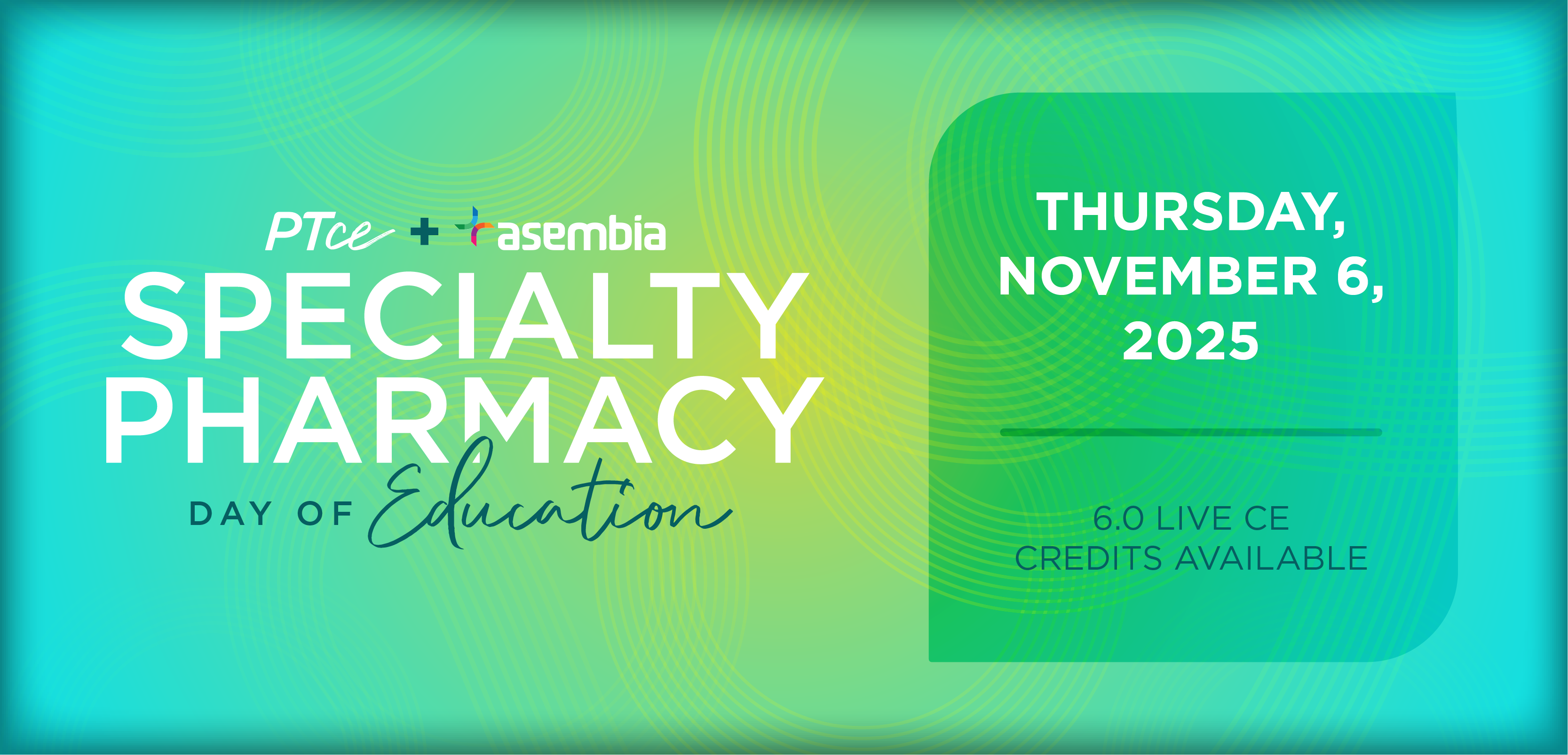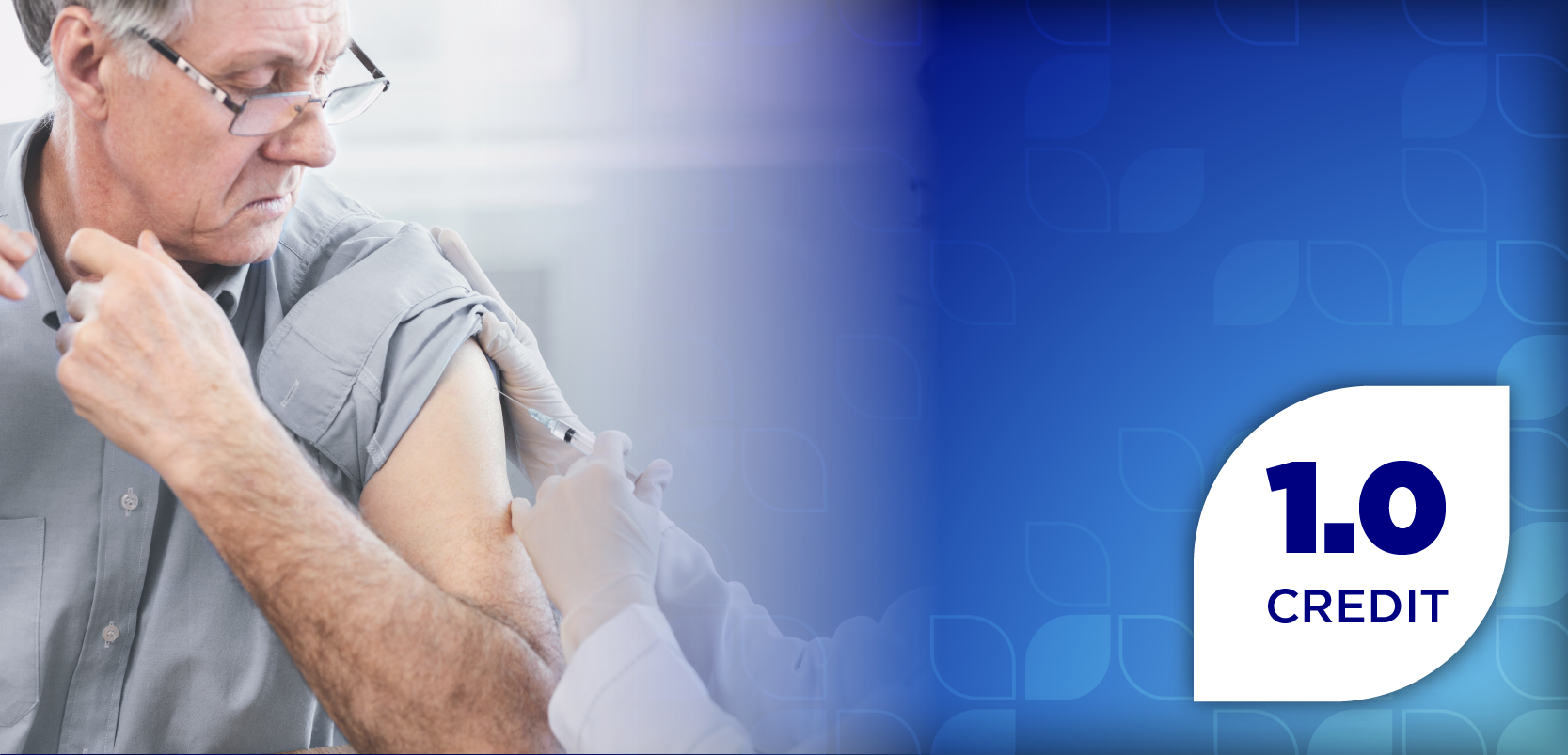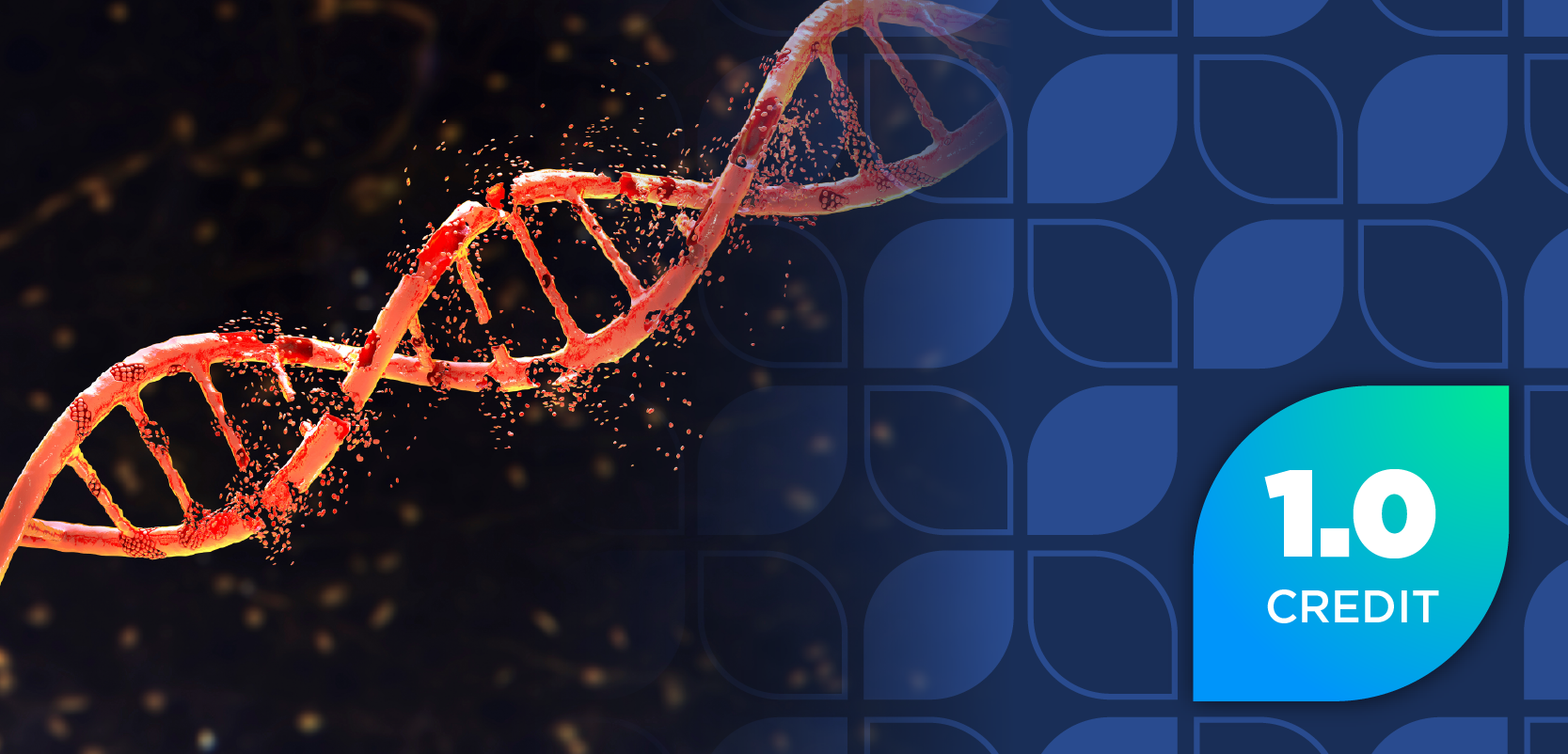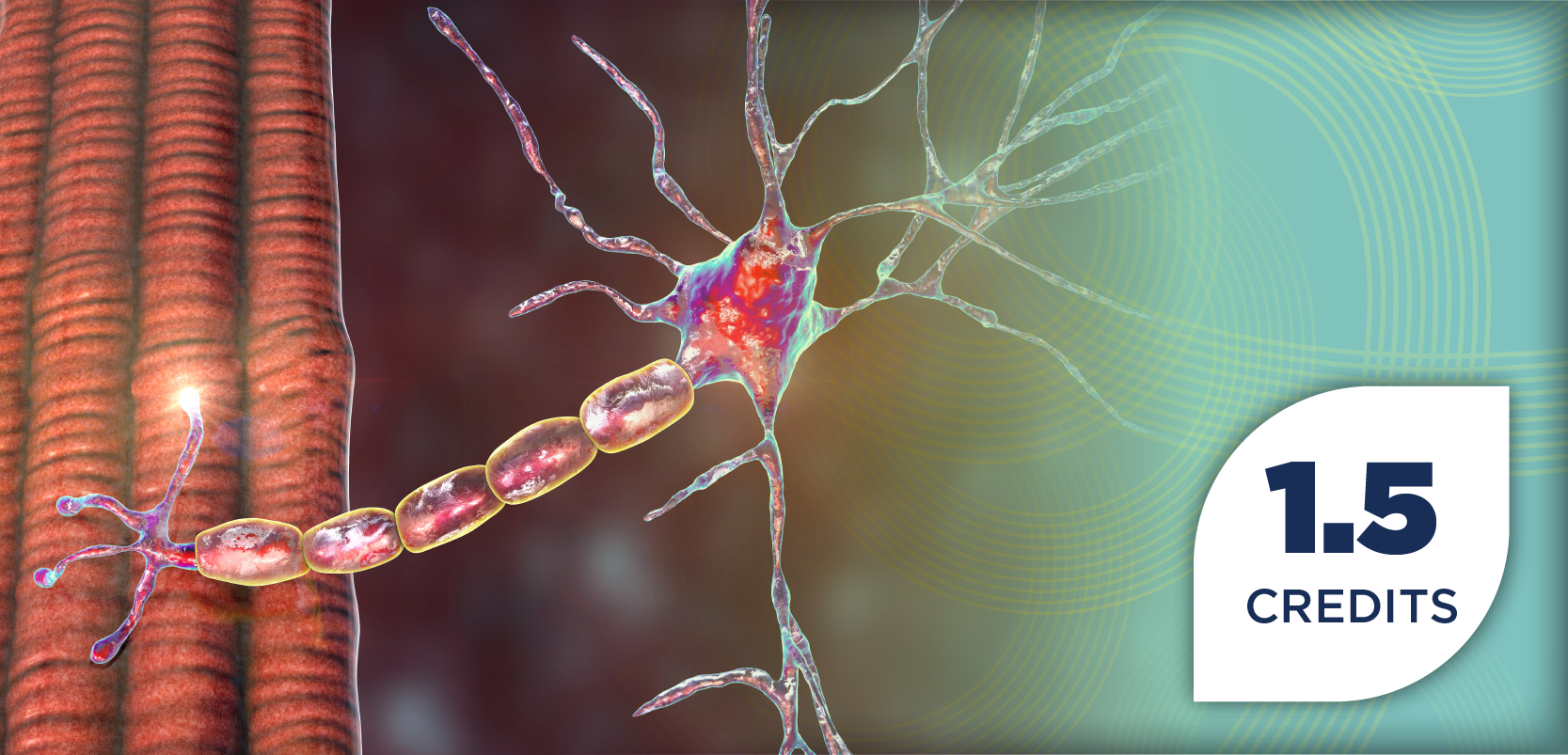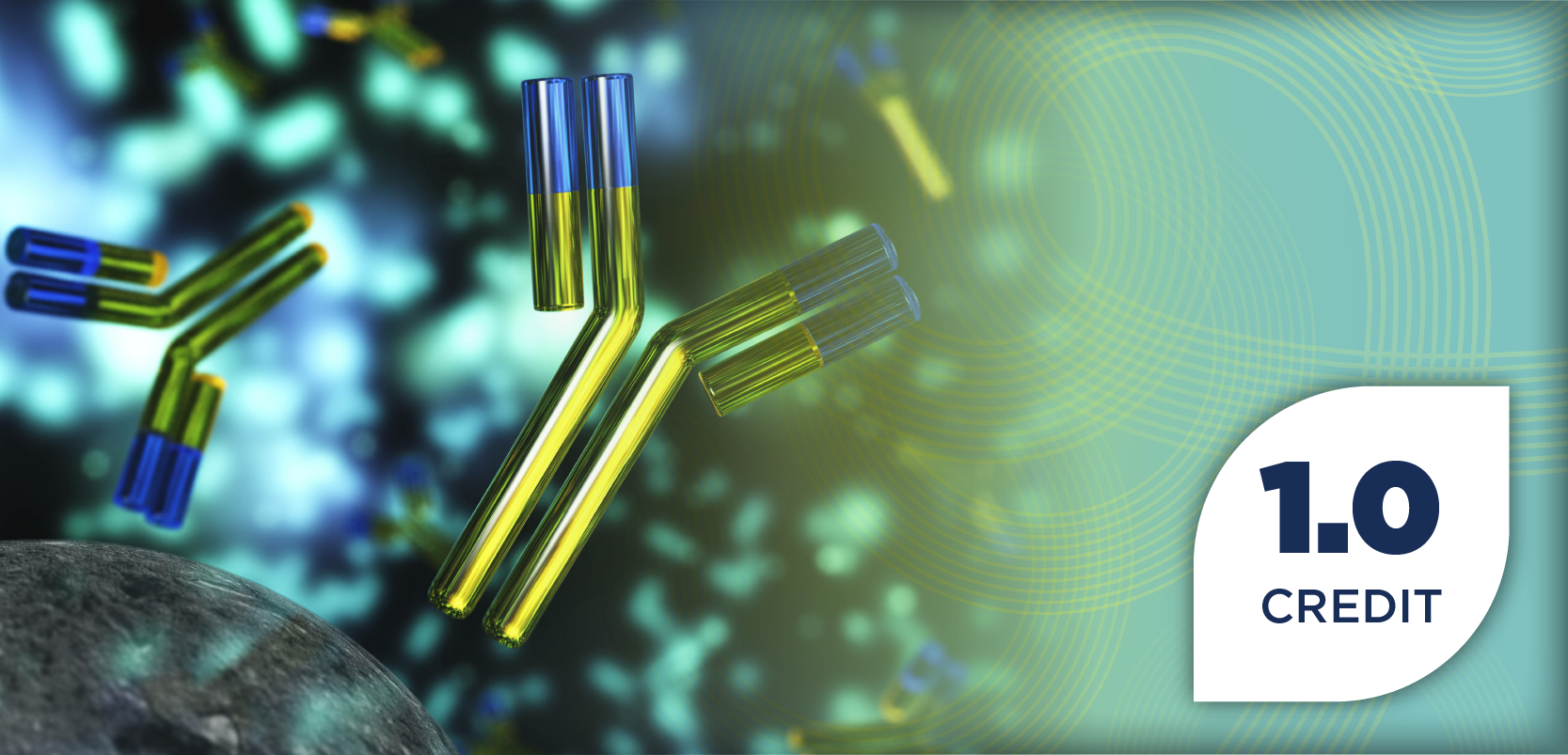Pharmacy Practice in Focus: Oncology
- October 2025
- Volume 7
- Issue 7
A Review of Antibody-Drug Conjugates for the Treatment of Urothelial Carcinoma: The Rise of Enfortumab Vedotin
Key Takeaways
- Enfortumab vedotin-ejfv (EV) targets nectin-4, showing efficacy in urothelial carcinoma (UC) and gaining approval as a first-line treatment.
- Combination of EV with pembrolizumab enhances outcomes, establishing a new standard of care for locally advanced or metastatic UC.
Enfortumab vedotin-ejfv has transformed treatment in locally advanced and metastatic urothelial carcinoma from decades-long platinum-based chemotherapy to the new standard of care combination of antibody-drug conjugate and PD-1/PD-L1 inhibitor.
Abstract
The recognition of enfortumab vedotin-ejfv (EV) as an effective therapeutic in urothelial carcinoma (UC) is supported by clinical trials such as EV-201, EV-301, EV-103/KEYNOTE-869, and EV-302/KEYNOTE-A39. EV is an antibody-drug conjugate (ADC) that targets nectin-4, a transmembrane protein highly expressed in UC. EV’s rise in locally advanced and metastatic UC took approximately 4 years from its initial accelerated approval in 2019 to its full approval as a first-line treatment in 2023. ADCs continue to represent a frontier for all cancers, with few having the impact that EV has had for UC. In addition to EC’s use in the treatment of UC, future clinical trial results may show that EC is effective in the perioperative setting and potentially other solid tumors. As with many anticancer therapeutics, caution should be taken, as EV can lead to unique adverse events while also having overlapping toxicities with PD-1/PD-L1 inhibitors. Pharmacists in the clinic or infusion center reviewing laboratory tests and assessing patients may provide a key link for patient monitoring, early detection, and toxicity management.
Introduction
Antibody-drug conjugates (ADCs) represent a promising frontier in targeted cancer therapy, combining the specificity of monoclonal antibodies with the cytotoxic efficacy of chemotherapy. Unlike traditional chemotherapy, which can damage cancerous and healthy cells, ADCs selectively target tumor cells, thereby reducing systemic toxicity and enhancing therapeutic precision.1 The ADC structure typically includes a monoclonal antibody specific to an antigen highly expressed on cancer cells, a cytotoxic drug (payload), and a linker that attaches the drug to the antibody. Upon binding to the target antigen, the ADC-antigen complex is internalized and the linker is cleaved, releasing the cytotoxic payload directly into the tumor cell to induce cell death and sparing the healthy tissue.2,3
Advances in ADC technology help addressed challenges that manifested with first-generation ADCs, such as off-target effects and instability. Second- and third-generation ADCs incorporate several improvements to allow higher drug-to-antibody ratios, employ stable linkers that reduce premature release, and maintain a lower presence of unconjugated antibodies to limit adverse effects (AEs).2,4 These modifications enhance the safety and efficacy of ADCs, improving their therapeutic potential across a broad range of malignancies.2,4 By focusing on tumor-specific markers, ADCs such as enfortumab vedotin-ejfv (EV; Padcev; Astellas Pharma US and Seagen) for urothelial carcinoma (UC) have achieved remarkable clinical success, broadening the horizons of cancer treatment. Continued research and advancements in ADC technology are anticipated to further refine their therapeutic profile, providing new and more effective treatment options for patients with difficult-to-treat cancers such as UC.
The prognosis for UC varies considerably based on the cancer’s stage at diagnosis and the patient’s response to treatment. For patients with early-stage, non–muscle-invasive cancer that remains within the bladder lining, the 5-year survival rate is approximately 90% due to effective localized treatments such as surgery and intravesical therapy with agents such as Bacillus Calmette-Guérin.1 However, in cases of locally advanced or metastatic UC (la/mUC) where cancer has spread to distant organs, survival rates decline sharply, with 5-year survival dropping to approximately 8% to 10%.5Historically, for metastatic cases, the treatment mainstay is platinum-based chemotherapy and then immunotherapy agents, specifically immune checkpoint inhibitors. In cases where patients are ineligible for chemotherapy or have specific genetic alterations, targeted treatments such as the FGFR inhibitor erdafitinib (Balversa; Janssen Biotech, Inc) are considered.6,7
Recent advancements in ADCs such as EV have expanded options for patients with advanced disease. The development of these ADCs underscores the shift toward targeted therapy in UC, providing new options for patients with limited alternatives. Ongoing research focuses on optimizing ADC delivery, exploring combination regimens, and identifying novel targets to further improve outcomes in UC.
Nectin-4 and Biomarker Use in Urothelial Carcinoma
Nectin-4 is a transmembrane protein highly expressed in UC that plays roles in cellular adhesion, cell differentiation, and cell proliferation.8 Nectin-4, also known as PVRL4, is a protein encoded by NECTIN4 and belongs to a family of 4 immunoglobulin-like proteins, nectin-1 through nectin-4.9 Through its role in cell adhesion, nectin-4 expression may promote cellular proliferation, tumor growth, motility, and immune modulation.8,10Nectin-4 has been found to be highly expressed in not only UC but several other solid tumors, such as breast, lung, and head and neck cancers. Nectin-4 is also moderately expressed in human skin, likely resulting in the variety of observed cutaneous toxicities.10 Nectin-4 expression may result in increased sensitivity to certain molecular subtypes. In one retrospective study of more than 1900 specimens, nectin-4 expression was critical for EV-induced cell death, and luminal subtypes exhibited the highest expression of the 6 subtypes (luminal papillary, luminal nonspecified, luminal unstable, basal/squamous, stroma-rich, and neuroendocrine-like).11
Because nectin-4 expression is anticipated to be widespread in mUC, preselection for nectin-4 as a biomarker was only done for the phase 1 EV-101 trial (NCT02091999).12 When a majority of patients were found to have high nectin-4 expression (H-score > 150; Table 1), the protocol was amended to remove nectin-4 expression as an enrollment requirement. It subsequently has not been required in any other EV trial and is not tested for in clinical practice.9,13
Pharmacokinetics and Pharmacodynamics
No significant differences in the pharmacokinetics of the ADC and unconjugated cytotoxic payload monomethyl auristatin E (MMAE) were noted following administration of EV as monotherapy or in combination with pembrolizumab (Keytruda; Merck & Co).14 EV is administered as a 30-minute intravenous infusion, with peak concentrations observed near the end of the infusion session. Peak concentration of the unconjugated MMAE was seen 2 days following EV infusion, and steady state concentrations were achieved after 1 treatment cycle. The volume of distribution of EV was 12.8 L at the estimated mean steady state.14
The ADC undergoes enzymatic catabolism, which leads to the production of small peptides, amino acids, unconjugated MMAE, and unconjugated MMAE-related catabolites. MMAE is released via proteolytic cleavage, whereas unconjugated MMAE is primarily metabolized via CYP3A4.14 ADC elimination displayed a half-life of approximately 3.6 days (87.2 hours).14 Elimination of MMAE appeared to be limited by its rate of release from EV and had a half-life of approximately 2.6 days (61.2 hours).15Although results were not reported in the EV package labeling, studies with brentuximab vedotin (Adcetris; Pfizer), another MMAE-containing ADC, demonstrated that the primary excretion route of MMAE cytotoxic payload was via feces.15
Regarding immunogenicity, the incidence of antitherapeutic antibodies was low (<3%) in clinical studies.15No significant pharmacokinetic differences in the components of EV were identified based on age, sex, race, renal impairment, or mild hepatic impairment (defined as total bilirubin of 1 to 1.5 times the upper limit of normal, or elevated aspartate aminotransferase and bilirubin within normal limits).14
Clinical Efficacy
EV has demonstrated significant clinical efficacy in the treatment of patients with mUC. EV’s success story in locally advanced and mUC (la/mUC) spans multiple treatment lines, initially as a third-line single agent until eventually replacing cisplatin as first-line treatment for all patients with locally advanced or metastatic disease. This journey of EV’s clinical efficacy in clinical trials spans EV-101, EV-201 (NCT03219333),16 EV-301 (NCT03474107),17EV-103/KEYNOTE-869 (NCT03288545)18 and EV-302/KEYNOTE-A39 (NCT04223856).19, 10, 20-23
EV-101 and EV-201
EV-101 was a phase 1 dose-escalation and expansion study that explored the safety, tolerability, and preliminary efficacy of EV in patients with advanced solid tumors, including UC. EV-101 established a recommended dose and provided early evidence of efficacy, particularly in patients with advanced UC who had prior treatment with immune checkpoint inhibitors.10
EV-201 was a phase 2, single-arm, multicenter trial. Cohort 1 included 125 patients previously treated with platinum chemotherapy and immunotherapy, and cohort 2 included 89 patients who were ineligible for platinum-based chemotherapy and had received immunotherapy only.20 This cohort addressed a significant gap in treatment, as patients who are ineligible for platinum-based chemotherapy and have progressed on immune checkpoint inhibitors typically have limited therapeutic options.
EV was administered intravenously at a dose of 1.25 mg/kg (up to a maximum dose of 125 mg) on days 1, 8, and 15 of every 28-day cycle. Patients were treated until disease progression, development of unacceptable toxicity, investigator decision, consent withdrawal, start of a subsequent anticancer therapy, pregnancy, or study termination by the sponsor. The primary end point was objective response rate (ORR) assessed by blinded independent central review, and secondary end points included duration of response (DOR), disease control rate at week 14, progression-free survival (PFS), and overall survival (OS).7,13,20 The trial reported an ORR of 44% (95% CI, 35.1-53.2), with complete responses in 12% of patients and partial responses in 32%. The median DOR was reported at 7.6 months (95% CI, 6.3-not estimable), with a median treatment duration of 4.6 months. Furthermore, the median PFS was 5.8 months, and the median OS was 11.7 months, suggesting significant clinical benefit in patients.20
Overall, EV showed clinical efficacy and a manageable safety profile in patients with la/mUC who did not succeed with standard therapies, making it a significant advancement in the treatment landscape for this malignancy. Supported by these data, the FDA granted accelerated approval on December 18, 2019, to EV for adult patients with locally advanced or metastatic urothelial cancer who have previously received a PD-1 or a PD-L1 inhibitor and a platinum-containing chemotherapy in the neoadjuvant/adjuvant, locally advanced, or metastatic setting.24
EV-301
The phase 3, open-label, randomized, multicenter trial EV-301 compared EV with standard chemotherapy (docetaxel, paclitaxel, or vinflunine) in patients with advanced UC previously treated with chemotherapy and a checkpoint inhibitor. The investigators reported a median OS of 12.88 months (95% CI, 10.6-15.2) for EV compared with 8.97 months (95% CI, 8.1-10.7) for chemotherapy (HR, 0.70; 95% CI, 0.56-0.89, P = .0014).21 This confirmed the survival benefit and supported the use of EV as a new standard of care in the second line and later for patients with advanced UC.21 Based on this study, on July 9, 2021, the FDA granted regular approval to EV for adult patients with la/mUC who have previously received a PD-1 or PD-L1 inhibitor and a platinum-containing chemotherapy, or who are ineligible for cisplatin-containing chemotherapy and have previously received 1 or more lines of therapy.25
EV-103/KEYNOTE-869 and EV-302/KEYNOTE-A39
Both EV and pembrolizumab have shown clinical activity as single agents in late-line settings. In addition, preclinical data have shown that EV in combination with PD-1/PD-L1 inhibitors may enhance antitumor activity. Investigators have moved their attention to the potential combination in the first-line setting.22
Cohort K of the phase 1/2 EV-103/KEYNOTE-869 trial included patients who had not received prior systemic therapy and were ineligible for cisplatin-containing regimen. They were randomly assigned to either the combination of EV and pembrolizumab (n=76) or EV alone (n=73). Approximately half of all patients with la/mUC are ineligible for cisplatin-based chemotherapy due to concomitant comorbidities such as impaired renal function, poor performance status, hearing loss, neuropathy, or heart failure.22 After a median follow-up of 14.8 months (95% CI, 12.9-17.3) in the combination arm and 15.0 months (95% CI, 12.7-17.4) in the monotherapy arm, the primary end point of ORR was 64.5% (95% CI, 52.7%-75.1%) in the combination group and 45.2% (95% CI, 33.5%-57.3%) in the enfortumab monotherapy group.22 The results of EV-103 represented a new therapeutic option as a first-line regimen for cisplatin-ineligible patients with la/mUC. On April 3, 2023, the FDA granted accelerated approval to EV with pembrolizumab for patients with la/mUC who are ineligible for regimens containing cisplatin.26
For platinum-eligible patients, platinum-based chemotherapy has been the standard of care for decades.23 EV-302/KEYNOTE-A39 was a phase 3, global, open-label, randomized trial of 886 patients with la/mUC who had had no prior systemic therapy. In the trial, patients received either combination EV plus pembrolizumab or platinum-based chemotherapy with gemcitabine and either cisplatin or carboplatin. The primary end points were PFS and OS.23
At a median follow-up of 17.2 months, the median PFS was 12.5 months (95% CI,10.4-16.6) in the combination arm vs 6.3 months (95% CI, 6.2-6.5) in the chemotherapy arm (HR, 0.45; 95% CI, 0.38-0.58; P < .001).23 The median OS was 31.5 months (95% CI, 25.4-not reached) in the combination arm vs 16.1 months (95% CI, 13.9-18.3) in the chemotherapy arm (HR, 0.47; 95% CI, 0.38-0.58; P < .001).23 An impressive 55% and 53% lower risk of disease progression or death in the combination arm compared with the chemotherapy arms, respectively, led to the FDA’s regular approval of EV and pembrolizumab for the first-line treatment of patients with la/mUC on December 15, 2023.27
Phase 3 Trials: Perioperative Treatment With Enfortumab
Building on the positive results of EV-302/KEYNOTE-A39, the EV and pembrolizumab combination is being evaluated as a potential option in the perioperative setting. Separate phase 3 clinical trials are underway for patients with muscle-invasive bladder cancer (MIBC) who are cisplatin-eligible or cisplatin-ineligible.
In the KEYNOTE-B15/EV-304 trial (NCT04700124),28 an estimated 784 cisplatin-eligible patients with MIBC will be randomly assigned 1:1 to receive perioperative EV plus pembrolizumab or standard neoadjuvant cisplatin-based chemotherapy. Patients are stratified by disease stage (T2N0 or T3/T4aN0 or T1-T4aN1), PD-L1 expression (combined positive score ≥ 10 or < 10), and geographic location (United States or other countries). The patients on the perioperative EV and pembrolizumab combination arm will receive 4 cycles of neoadjuvant EV and pembrolizumab followed by 5 cycles of adjuvant EV plus 13 cycles of adjuvant pembrolizumab therapy after radical cystectomy and pelvic lymph node dissection (RC+PLND). Patients in the chemotherapy arm will receive 4 cycles of gemcitabine-cisplatin followed by observation after RC+PLND. The primary end points are pathological complete response (pCR) and event-free survival (EFS), with secondary end points including OS, disease-free survival (DFS), and safety.29
The preliminary readout for KEYNOTE-B15/EV-304 is expected later in 2025. Although the investigators aim to establish the EV and pembrolizumab combination as a perioperative option for patients with MIBC who are cisplatin-eligible, it is uncertain whether these early results will be readily adopted. Based on the results of the phase 3 VESPER trial (NCT01812369),30 dose-dense methotrexate, vinblastine, doxorubicin, and cisplatin (dd-MVAC) was shown to improve PFS compared with gemcitabine and cisplatin. Therefore, although gemcitabine plus cisplatin is a reasonable treatment option, dd-MVAC has become the preferred platinum-based regimen in this setting.31
In addition, the NIAGARA study (NCT03732677)32 recently demonstrated that the addition of durvalumab to perioperative gemcitabine and cisplatin led to improvement in EFS and OS compared with gemcitabine plus cisplatin alone.33 Therefore, depending on the results of KEYNOTE-B15/EV-304, the EV plus pembrolizumab combination may have an additional role in this setting.33
In KEYNOTE-905/EV-303 (NCT03924895),34 approximately 857 patients with MIBC who are ineligible for or decline cisplatin-based therapy will be randomly assigned into 3 arms: neoadjuvant pembrolizumab, followed by surgery and adjuvant pembrolizumab (arm A); surgery followed by observation (arm B); or neoadjuvant EV and pembrolizumab, surgery, and adjuvant EV and pembrolizumab (arm C). Similar to KEYNOTE-B15/EV-304, the primary end points are pCR and EFS. Secondary end points include OS, DFS, pathologic downstaging rates, and treatment safety and tolerability.35
Dosing Considerations
EV is dosed at 1.25 mg/kg intravenously over 30 minutes on days 1, 8, and 15 of a 28-day cycle (maximum dose, 125 mg) as monotherapy based on the benefit/risk ratio compared with lower doses. This dosing regimen is recommended by the FDA based on results of the phase 1 EV-101 study. Patients received incremental doses ranging from 0.5 to 1.25 mg/kg. Most patients with mUC received the 1.25 mg/kg dose (Table 2). Of note, in EV-302/KEYNOTE-A39, when EV is combined with pembrolizumab, EV is given on days 1 and 8 of a 21-day cycle instead of days 1, 8, and 15 of a 28-day cycle. When given in combination with pembrolizumab, EV is still given at a dose of 1.25 mg/kg with a maximum dose of 125 mg per dose, and with pembrolizumab at a dose of 200 mg being administered after EV on day 1.10
Investigators decided not to study doses higher than 1.25 mg/kg because patients experienced drug-related rash and diarrhea, which required dose reductions at rates higher than those at lower doses.10 A total of 35% of patients taking the 1.25-mg/kg dose needed a dose reduction, whereas 11% and 0% needed dose reductions for AEs when they were started at 1.0 and 0.75 mg/kg, respectively. The confirmed ORRs for the starting doses of 1.25, 1.0, 0.75, and 0.5 mg/kg were 42.9%, 18.5%, 21.4%, and 50%, respectively.10 Study results show that increased exposure at doses greater than 1.25 mg/kg is not predicted to improve clinical efficacy.15 A dose cap of 125 mg was added in the protocol amendment of EV-201 due to treatment-related fatal events in patients with baseline body weight of 100 kg or higher.15 A dose cap was chosen instead of a weight cutoff, as lower weight cutoffs of 85 kg resulted in greater exposure variability and possible underdosing.20The EV maximum dose also carries through each level of dose reduction, so a 1-mg/kg dose would have a maximum dose of 100 mg, a 0.75-mg/kg dose would have a maximum dose of 75 mg, and a 0.5-mg/kg dose would have a maximum dose of 50 mg.14
Safety and AEs
Skin Toxicity
Nectin-4 is moderately expressed in normal human skin in skin keratinocytes, which form the bulk of the epidermis, as well as skin appendages, such as hair follicles, sebaceous glands, and sweat glands. This expression means cutaneous toxicities are an anticipated on-target toxicity.10 The onset of many skin reactions is relatively quick, with the median onset of skin reactions in EV-301 occurring at 0.4 months.21 This is consistent with EV’s pharmacokinetics, as steady state concentrations are achieved after 1 treatment cycle, and peak ADC concentrations were observed near the end of the intravenous infusion.20
EV in combination with pembrolizumab demonstrated a higher incidence rate of skin reactions compared with monotherapy.20 Based on clinical trial data, skin reactions occurred in 58% of patients who received EV as monotherapy and 70% of patients who received EV in combination with pembrolizumab. Overlapping dermatologic toxicity from EV and immune-related dermatologic toxicity adds additional layers of complexity during diagnosis and management. Skin reactions reported with EV therapy included maculopapular rash, bullous dermatitis, dermatitis, exfoliative dermatitis, and erythematous rash.36 Severe fatal cases of Stevens-Johnson syndrome (SJS) and toxic epidermal necrolysis (TEN) were reported in patients who received EV. Skin reactions seen with EV most frequently occurred following the first cycle of treatment but may also present during future treatment cycles. Common signs and symptoms of potential SJS and TEN include desquamating rash associated with malaise, fever (≥38 °C), mucosal involvement (ocular, oral, genital), and skin pain.36 The median onset reported in clinical trials with EV monotherapy was 0.6 months (range, 0.1-8) compared with 1.7 months (range, 0.1-17.2) in combination with pembrolizumab. Rate of grade 3 or higher severe skin reactions ranged from 14% to 17%. More than half of patients (59%) who experienced a skin reaction were able to achieve complete resolution following treatment discontinuation.36
Peripheral Neuropathy
Peripheral neuropathy is a well-documented AE of ADCs and is believed to be mediated by MMAE. Peripheral neuropathy of any kind, including sensory and motor neuropathy, is observed in almost 50% of patients treated with EV.10,21 Peripheral neuropathy and skin reactions are the most frequent treatment-related AEs of special interest.21
In EV-301, peripheral neuropathy primarily manifested as sensory events and was the most common treatment-related AE that resulted in dose reduction, interruption, or withdrawal of treatment in patients treated with EV.36 EV in combination with pembrolizumab was associated with a higher incidence of peripheral neuropathy compared with monotherapy (67% vs 53%, respectively). Peripheral neuropathy was reported in patients with or without baseline neuropathy prior to initiation of EV. The median time to onset of grade 2 or higher peripheral neuropathy was approximately 6 months (range, 0.3-25). Of the patients who experienced neuropathy, 87% reported residual neuropathy at their last follow-up after discontinuing EV.36
Hyperglycemia
Hyperglycemia of any grade was seen in 17% of patients who received EV as a single agent in the monotherapy clinical trials, with 7% of patients developing grade 3 or higher. One patient (0.1%) developed a fatal case of hyperglycemia, and 1 developed a fatal case of diabetic ketoacidosis. Higher body mass index and baseline hemoglobin A1c (HbA1c) levels were associated with increased risk of grade 3 or higher hyperglycemia. The median onset of hyperglycemia was approximately 2 weeks in both EV monotherapy and in combination with pembrolizumab. Of note, patients with baseline HbA1c of 8% or higher were excluded from clinical trials. Hyperglycemia led to discontinuation of EV in 0.7% of patients and initiation of insulin for hyperglycemia management in 5% of patients.22 A blood glucose level of greater than 250 mg/dL warrants withholding EV, according to manufacturer labeling.14
Pneumonitis/Interstitial Lung Disease
The incidence of pneumonitis or interstitial lung disease occurred at a higher rate when EV was administered in combination with pembrolizumab. Approximately 10% of patients experienced these AEs in the clinical trials vs approximately 3% of patients who received monotherapy. Approximately 4% of patients experienced grade 3 or greater AEs with combination therapy vs 0.8% observed with monotherapy. The development of pneumonitis or interstitial lung disease led to death in 2 patients (0.4%) who received combination therapy. The median time to onset of any-grade pneumonitis was 4 months (range, 0.3-26).36 EV-related pneumonitis should be closely monitored, as some trial sites have reported higher incidences. A retrospective study looking at patients who were enrolled in EV-201 and EV-301 across institutions in South Korea found that pneumonitis occurred in approximately 25% of those patients, including 2 fatal events.37
Ocular Toxicity
Although ocular toxicities with EV are not as common as with other ADCs, EV can still cause severe AEs. Ocular disorders were reported in 40% of patients, based on clinical trial data of EV as a single agent.14 Many of these toxicities involved keratitis, blurred vision, conjunctivitis, and limbal stem cell deficiency.14 However, corneal-specific disorders may be low, with only 2 patients in the EV group of EV-301 reported to have corneal disorders, with a median onset of 4.3 months.21 The exact pathology of EV-induced ocular toxicities is not known, although it is likely a combination of on-target and off-target effects with nectin-4 on the surface of corneal epithelial cells, as well as MMAE payload reaching the ocular surfaces of the cornea. Corneal pseudomicrocysts and microcystlike epithelial changes with ADCs such as belantamab mafodotin and mirvetuximab soravtansine have not been reported with EV,and currently there are no recommendations for routine use of premedication eye drops or routine ophthalmic examinations, unlike with other ADCs.14,38
Other ADCs
EV-302/KEYNOTE-A39 confirmed EV’s initial accelerated approval; however, not all ADCs have had similar success. Sacituzumab govitecan (SG, Trodelvy; Gilead Sciences) targets Trop-2, a transmembrane glycoprotein involved in tumor growth and progression that is highly expressed in many epithelial cancers.8,13 However, after failing to meet its primary end point of OS in the confirmatory phase 3 TROPiCS-04 trial (NCT04527991),39 the FDA announced the withdrawal of approval for SG for patients with la/mUC who previously received a platinum-containing chemotherapy and either a PD-1 or PD-L1 inhibitor.40,41
Two potential ADCs in urothelial carcinoma are trastuzumab deruxtecan (T-Dxd, Darzalex; Janssen Biotech) and datopotamab deruxtecan (Dato-Dxd, Datroway; Daiichi Sankyo, Inc). T-Dxd, a HER2-directed antibody linked to a topoisomerase inhibitor, was studied in the open-label, phase 2 DESTINY-PanTumor02 study (DP-02; NCT04482309).42 DP-02 evaluated T-Dxd (5.4mg/kg every 3 weeks) in patients with solid tumor HER2-expression by immunohistochemistry (IHC) testing in la/mUC after 1 or more systemic treatments.43,44 Preliminary results in the UC cohort had a median follow-up of 12.65 months (range, 0.4-26.8) and a confirmed ORR of 39% (95% CI, 24.2%-55.5%), with a numerically higher ORR in HER2 IHC 3+ (56.3%; 95% CI, 29.9%-80.2%) compared with HER2 IHC2+ (35%; 95% CI, 15.4%-59.2%).43 T-Dxd is approved for UC under its tumor-agnostic FDA approval for solid tumor patients with HER2 IHC3+.44 In the phase 1 TROPION-PanTumor01 study (NCT03401385),45 patients with unresectable la/mUC who had 1 or more prior lines of systemic therapy received Dato-Dxd, a Trop-2–directed antibody conjugated to a topoisomerase inhibitor (6 mg/kg every 3 weeks).46,47 At a median follow-up of 9.1 months (range, 5 to 17), Dato-Dxd had an ORR of 27.8% (95% CI, 9.7%-53.5%).46,47 It remains to be seen whether T-Dxd or Dato-Dxd will ever challenge the current standard of care in la/mUC, EV and pembrolizumab.
Novel Therapies and Future Directions
Although EV is used regardless of nectin-4 expression on tumor cells, study results presented at the 2024 European Society of Medical Oncology demonstrated the use of blood levels of nectin-4 as a potential predictive biomarker with EV treatment.48 The investigators did find that the degree of invasiveness and metastasis correlated with higher serum nectin-4 levels, but future studies may evaluate whether these levels better predict EV response.20,48
Beyond bladder cancer, EV is being evaluated as a potential third-line or beyond treatment option in other tumor types. In the phase 2 EV-202 trial (NCT04225117),49-51 6 different cohorts of previously treated patients received EV, comprising those with hormone receptor-positive/HER2-negative breast cancer, triple-negative breast cancer, squamous non–small cell lung cancer (NSCLC), nonsquamous non–small-cell lung cancer, head and neck cancer, or gastric or gastroesophageal junction cancer.50,51 In general, these patients are treated with single-agent chemotherapy options that are often associated with low response rates and significant toxicities. Based on the interim analysis for the breast and lung cancer cohorts, EV showed limited efficacy but improved safety when compared with historical controls.50,51 The trial will determine whether there is further utility in other tumor types.
In direct competition with EV, similar ADCs targeting nectin-4 are in the pipeline (TABLE 3). For example, the phase 1 study (NCT05701709)52 investigated SHR-A2102 at different doses in patients who have advanced or metastatic solid tumors that are nectin-4–positive and have progressed after standard treatments.53 Study participants had UC, NSCLC, breast cancers, gastric and gastroesophageal junction adenocarcinoma, or other tumors expressing nectin-4. An initial report showed that SHR-A2102 had an ORR of 31.3% in patients with NSCLC (n = 16); the ORR was 50% for those with nonsquamous NSCLC (n = 8) and 12.5% for those with squamous NSCLC (n = 8).53 At the 2025 American Society of Clinical Oncology Genitourinary Cancers Symposium, the study investigators shared that the total UC cohort (n = 73) had an ORR of 38.4%.40 Those previously treated with an ADC (n = 31) had an ORR of 38.7%, suggesting sequential ADCs could potentially retain efficacy. However, 43.8% of patients did experience a treatment-related AE of grade 3 or worse, with the most common being hematologic in nature. 54
Another ADC that targets nectin-4 is bulumtatug fuvedotin (BFv; 9MW2821; Mabwell Bioscience). In an open-label, phase 1/2 study (NCT05216965)55 of patients with advanced solid tumors, BFv demonstrated an ORR of 26.2% in the total population, which also included patients with breast or cervical cancers.56 For the 37 patients with UC previously treated with platinum-based chemotherapy and an immune checkpoint inhibitor, the ORR was 54.1%.56
Conclusion
With the positive results of EV-302/KEYNOTE-A39, EV has become the new standard of care for first-line therapy regardless of whether the patient is platinum eligible. EV and pembrolizumab now provide patients with la/mUC a superior treatment option without cytotoxic chemotherapy. This combination may also be advantageous for many patients with UC with comorbidities and difficulty meeting cisplatin eligibility. Future studies such as KEYNOTE-A39/EV-304 and EV-202 will likely expand the treatment setting of EV with possible treatment options in the perioperative setting and other solid tumors. As more ADCs are approved, it is vital that pharmacists must develop and apply the expertise needed to effectively treat patients and safely manage these ADCs.
REFERENCES
1.Phuna ZX, Kumar PA, Haroun E, Dutta D, Lim SH. Antibody-drug conjugates: principles and opportunities. Life Sci. 2024;347:122676. doi:10.1016/j.lfs.2024.122676
2.Beck A, Goetsch L, Dumontet C, Corvaïa N. Strategies and challenges for the next generation of antibody–drug conjugates. Nat Rev Drug Discov. 2017;16(5):315-337. doi:10.1038/nrd.2016.268
3.Barok M, Puhka M, Yazdi N, Joensuu H. Extracellular vesicles as modifiers of antibody-drug conjugate efficacy. J Extracell Vesicles. 2021;10(4):e12070. doi:10.1002/jev2.12070
4.Chari RVJ, Miller ML, Widdison WC. Antibody–drug conjugates: an emerging concept in cancer therapy. Angew Chem Int Ed Engl. 2014;53(15):3796-3827. doi:10.1002/anie.201307628
5.What is bladder cancer? National Cancer Institute. Updated February 16, 2023. Accessed October 25, 2024. https://www.cancer.gov/types/bladder
6.D’Angelo A, Chapman R, Sirico M, et al. An update on antibody-drug conjugates in urothelial carcinoma: state of the art strategies and what comes next. Cancer Chemother Pharmacol. 2022;90(3):191-205. doi:10.1007/s00280-022-04459-7
7.Thomas J, Sun M, Getz T, Ho B, Nauseef JT, Tagawa ST. Antibody-drug conjugates for urothelial carcinoma. Urol Oncol. 2023;41(10):420-428. doi:10.1016/j.urolonc.2023.06.006
8.Wong JL, Rosenberg JE. Targeting nectin-4 by antibody-drug conjugates for the treatment of urothelial carcinoma. Expert Opin Biol Ther. 2021;21(7):863-873. doi:10.1080/14712598.2021.1929168
9.Klümper N, Eckstein M. Biomarkers of response to anti-NECTIN4 antibody-drug conjugate enfortumab vedotin in urothelial cancer. Eur Urol Focus. 2024;10(2):224-226. doi:10.1016/j.euf.2024.04.001
10.Rosenberg J, Sridhar SS, Zhang J, et al. EV-101: a phase I study of single-agent enfortumab vedotin in patients with nectin-4–positive solid tumors, including metastatic urothelial carcinoma. J Clin Oncol. 2020;38(10):1041-1049. doi:10.1200/JCO.19.02044
11.Chu CE, Sjöström M, Egusa EA, et al. Heterogeneity in NECTIN4 expression across molecular subtypes of urothelial cancer mediates sensitivity to enfortumab vedotin. Clin Cancer Res. 2021;27(18):5123-5130. doi:10.1158/1078-0432.CCR-20-4175
12.A study of escalating doses of asg-22ce given as monotherapy in subjects with metastatic urothelial cancer and other malignant solid tumors that express nectin-4. Updated November 1, 2024. Accessed August 6, 2025. https://clinicaltrials.gov/study/NCT02091999
13.Rosenberg JE, O’Donnell PH, Balar AV, et al. Pivotal trial of enfortumab vedotin in urothelial carcinoma after platinum and anti-programmed death 1/programmed death ligand 1 therapy. J Clin Oncol. 2019;37(29):2592-2600. doi:10.1200/JCO.19.01140
14.Padcev. Prescribing information. Seagen Inc; 2022. Accessed April 1, 2025. https://astellas.us/docs/PADCEV_label.pdf
15.Tang M, Garg A, Bonate PL, et al. Clinical pharmacology of the antibody–drug conjugate enfortumab vedotin in advanced urothelial carcinoma and other malignant solid tumors. Clin Pharmacokinet. 2024;63(4):423-438. doi:10.1007/s40262-024-01369-0
16.A study of enfortumab vedotin for patients with locally advanced or metastatic urothelial bladder cancer (EV-201). Updated August 27, 2024. Accessed August 6, 2025. https://clinicaltrials.gov/study/NCT03219333
17.A study to evaluate enfortumab vedotin versus (vs) chemotherapy in subjects with previously treated locally advanced or metastatic urothelial cancer (EV-301). Updated May 2, 2025. Accessed August 6, 2025. https://clinicaltrials.gov/study/NCT03474107
18.A study of enfortumab vedotin alone or with other therapies for treatment of urothelial cancer (EV-103). Updated May 2, 2025. Accessed August 6, 2025. https://clinicaltrials.gov/study/NCT03288545
19.Enfortumab vedotin and pembrolizumab vs. chemotherapy alone in untreated locally advanced or metastatic urothelial cancer (EV-302). Updated June 13, 2025. Accessed August 6, 2025. https://clinicaltrials.gov/study/NCT04223856
20.Yu EY, Petrylak DP, O’Donnell PH, et al. Enfortumab vedotin after PD-1 or PD-L1 inhibitors in cisplatin-ineligible patients with advanced urothelial carcinoma (EV‑201): a multicentre, single-arm, phase 2 trial. Lancet Oncol. 2021;22(6):872-882. doi:10.1016/S1470-2045(21)00094-2
21.Powles T, Rosenberg JE, Sonpavde GP, et al. Enfortumab vedotin in previously treated advanced urothelial carcinoma. N Engl J Med. 2021;384(12):1125-1135. doi:10.1056/NEJMoa2035807
22.O’Donnell PH, Milowsky MI, Petrylak DP, et al. Enfortumab vedotin with or without pembrolizumab in cisplatin-ineligible patients with previously untreated locally advanced or metastatic urothelial cancer. J Clin Oncol. 2023;41(25):4107-4117. doi:10.1200/JCO.22.02887
23.Powles T, Valderrama BP, Gupta S, et al; EV-302 Trial Investigators. Enfortumab vedotin and pembrolizumab in untreated advanced urothelial cancer. N Engl J Med. 2024;390(10):875-888. doi:10.1056/NEJMoa2312117
24.FDA grants accelerated approval to enfortumab vedotin-ejfv for metastatic urothelial cancer. FDA. Updated December 19, 2019. Accessed April 26, 2025. https://www.fda.gov/drugs/resources-information-approved-drugs/fda-grants-accelerated-approval-enfortumab-vedotin-ejfv-metastatic-urothelial-cancer
25.FDA grants regular approval to enfortumab vedotin-ejfv for locally advanced or metastatic urothelial cancer. FDA. July 9, 2021. Accessed April 26, 2025. https://www.fda.gov/drugs/resources-information-approved-drugs/fda-grants-regular-approval-enfortumab-vedotin-ejfv-locally-advanced-or-metastatic-urothelial-cancer
26.FDA grants accelerated approval to enfortumab vedotin-ejfv with pembrolizumab for locally advanced or metastatic urothelial carcinoma. FDA. April 3, 2023. Accessed April 26, 2025. https://www.fda.gov/drugs/resources-information-approved-drugs/fda-grants-accelerated-approval-enfortumab-vedotin-ejfv-pembrolizumab-locally-advanced-or-metastatic
27.FDA approves enfortumab vedotin-ejfv with pembrolizumab for locally advanced or metastatic urothelial cancer. FDA. December 15, 2023. Accessed April 26, 2025. https://www.fda.gov/drugs/resources-information-approved-drugs/fda-approves-enfortumab-vedotin-ejfv-pembrolizumab-locally-advanced-or-metastatic-urothelial-cancer
28.Perioperative enfortumab vedotin (EV) plus pembrolizumab (MK-3475) versus neoadjuvant chemotherapy for cisplatin-eligible muscle invasive bladder cancer (MIBC) (MK-3475-B15/ KEYNOTE-B15 / EV-304) (KEYNOTE-B15). Updated December 24, 2024. Accessed August 6, 2025. https://clinicaltrials.gov/study/NCT04700124
29.Hoimes CJ, Bedke J, Loriot Y, et al. KEYNOTE-B15/EV-304: Randomized phase 3 study of perioperative enfortumab vedotin plus pembrolizumab versus chemotherapy in cisplatin-eligible patients with muscle-invasive bladder cancer (MIBC). J Clin Oncol. 2021;39(suppl 15):4587. https://doi.org/10.1200/JCO.2021.39.15_suppl.TPS4587
30.Perioperative chemotherapy for patients with locally advanced bladder cancer (VESPER). Updated January 14, 2024. Accessed August 6, 2025. https://clinicaltrials.gov/study/NCT01812369
31.Pfister C, Gravis G, Flechon A, et al. Perioperative dose-dense methotrexate, vinblastine, doxorubicin, and cisplatin in muscle-invasive bladder cancer (VESPER): survival endpoints at 5 years in an open-label, randomised, phase 3 study. The Lancet Oncology. 2024;25(2):255-264. DOI: 10.1016/S1470-2045(23)00587-9
32.Durvalumab+ gemcitabine/ cisplatin (neoadjuvant treatment) and durvalumab (adjuvant treatment) in patients with MIBC (NIAGARA). Updated July 3, 2025. Accessed August 6, 2025. https://clinicaltrials.gov/study/NCT03732677
33.Powles T, Catto JWF, Galsky MD, et al. Perioperative Durvalumab with Neoadjuvant Chemotherapy in Operable Bladder Cancer. N Engl J Med. 2024;391:1773-1786. DOI: 10.1056/NEJMoa2408154
34.Perioperative pembrolizumab (MK-3475) plus cystectomy or perioperative pembrolizumab plus enfortumab vedotin plus cystectomy versus cystectomy alone in participants who are cisplatin-ineligible or decline cisplatin with muscle-invasive bladder cancer (MK-3475-905/ KEYNOTE-905/ EV-303). Updated July 14, 2025. Accessed August 6, 2025. https://www.clinicaltrials.gov/study/NCT03924895
35.Necchi A, Bedke J, Galsky MD, et al. Phase 3 KEYNOTE-905/EV-303: Perioperative pembrolizumab (pembro) or pembro + enfortumab vedotin (EV) for muscle-invasive bladder cancer (MIBC). 2023;41(suppl 6):585. https://doi.org/10.1200/JCO.2023.41.6_suppl.TPS585.
36.Brower B, McCoy A, Ahmad H, et al. Managing potential adverse events during treatment with enfortumab vedotin + pembrolizumab in patients with advanced urothelial cancer. Front Oncol. 2024;14:1326715. doi:10.3389/fonc.2024.1326715
37.Yoon S, Shin SJ, Kim HC, et al. Enfortumab vedotin-related pneumonitis is more common than expected and could lead to acute respiratory failure. Eur J Cancer. 2022;174:81-89. doi:10.1016/j.ejca.2022.07.014
38.Raheem F, Alsuhebany N, Hickey Zacholski E, et al. Ocular toxicities associated with antibody drug conjugates and immunotherapy in oncology: clinical presentation, pathogenesis, and management strategies. Expert Opin Drug Saf. 2023;22(10):921-928. doi:10.1080/14740338.2023.2251380
39.Study of sacituzumab govitecan versus physician’s choice of treatment in participants with urothelial cancer that cannot be removed or has spread (TROPiCS-04). Updated August 3, 2025. Accessed August 6, 2025. https://clinicaltrials.gov/study/NCT04527991
40.Powles T, Tagawa S, Vulsteke C, et al. Sacituzumab govitecan in advanced urothelial carcinoma: TROPiCS-04, a phase III randomized trial. Annals of Oncology. 2025;36(5):561-571. https://doi.org/10.1016/j.annonc.2025.01.011
41.FDA grants accelerated approval to sacituzumab govitecan for advanced urothelial cancer. FDA. November 25, 2024. Accessed April 27, 2025. https://www.fda.gov/drugs/resources-information-approved-drugs/fda-grants-accelerated-approval-sacituzumab-govitecan-advanced-urothelial-cancer
42.A phase 2 study of T-DXd in patients with selected her2 expressing tumors (DPT02). Updated July 22, 2025. Accessed August 6, 2025. https://clinicaltrials.gov/study/NCT04482309
43.Wysocki PJ, Jung KH, Oh DY, et al. Efficacy and safety of trastuzumab deruxtecan (T-DXd) in patients (pts) with HER2-expressing solid tumors: results from the bladder cohort of the DESTINY-PanTumor02 (DP-02) study. J Clin Oncol. 2024;42(suppl 16):4565. doi:10.1200/JCO.2024.42.16_suppl.4565
44.Enhertu. Prescribing information. Daiichi Sankyo, Inc.; 2025. Accessed April 1, 2025. https://daiichisankyo.us/prescribing-information-portlet/getPIContent?productName=Enhertu&inline=true.
45.First-in-human study of DS-1062a for advanced solid tumors (TROPION-PanTumor01). Updated May 20, 2025. Accessed August 6, 2025. https://clinicaltrials.gov/study/NCT03401385
46.Lisberg A, Drakaki A, Meric-Bernstam F, et al. Datopotamab deruxtecan in locally advanced/metastatic urothelial cancer: preliminary results from the phase 1 TROPION-PanTumor01 study. J Clin Oncol. 2024;42(suppl 4):603. doi:10.1200/JCO.2024.42.4_suppl.603
47.Datroway. Prescribing information. Daiichi Sankyo, Inc.; 2025. Accessed April 1, 2025. https://daiichisankyo.us/prescribing-information-portlet/getPIContent?productName=Datroway&inline=true.
48.Klümper N, Tran NK, Zschäbitz S, et al. NECTIN4 Amplification Is Frequent in Solid Tumors and Predicts Enfortumab Vedotin Response in Metastatic Urothelial Cancer . J Clin Oncol. 2024;42(40)2446-2455. DOI: https://doi.org/10.1200/JCO.23.019838
49.A study to evaluate enfortumab vedotin in subjects with locally advanced or metastatic malignant solid tumors (EV-202). Updated August 1, 2025. Accessed August 6, 2025. https://www.clinicaltrials.gov/study/NCT04225117
50.Wang Y, Li G, Wang H, Qi Q, Wang X, Lu H. Targeted therapeutic strategies for nectin-4 in breast cancer: recent advances and future prospects. Breast. 2025;79:103838. doi:10.1016/j.breast.2024.103838
51.Muro K, Feinstein T, Baranda JC, et al. Enfortumab vedotin (EV) in non-squamous and squamous non–small cell lung cancer (NSCLC) cohorts of EV-202. J Clin Oncol. 2024;42(suppl 16):8585. doi:10.1200/JCO.2024.42.16_suppl.8585
52.Phase I study of SHR-A2102 in patients with advanced solid tumors. Updated July 22, 2025. Accessed August 6, 2025. https://clinicaltrials.gov/study/NCT05701709
53.Zhong H, Zhong R, Qiao R, et al. Phase I study of SHR-A2102, a nectin-4 targeted ADC, in patients with advanced solid tumors. Ann Oncol. 2024;35(suppl 2):513. doi:10.1016/j.annonc.2024.08.715
54.Tang B, Sheng X, Guo J, et al. Nectin-4 targeted ADC, SHR-A2102, in patients with advanced or metastatic urothelial carcinoma: a phase 1 study. JCO. 2025;43(suppl 5):657-657. doi:10.1200/JCO.2025.43.5_suppl.657
55.A clinical study of 9MW2821 in subjects with advanced malignant solid tumors. Updated June 15, 2022. Accessed August 6, 2025. https://clinicaltrials.gov/study/NCT05216965
56.Zhang J, Liu R, Wang S, et al. Bulumtatug fuvedotin (BFv, 9MW2821), a next-generation nectin-4 targeting antibody-drug conjugate, in patients with advanced solid tumors: a first-in-human, open-label, multicenter, phase I/II study. Ann Oncol. 2025;36(8):934-943. doi:10.1016/j.annonc.2025.04.009
Articles in this issue
20 days ago
Current and Emerging BCMAxCD3 BispecificsNewsletter
Stay informed on drug updates, treatment guidelines, and pharmacy practice trends—subscribe to Pharmacy Times for weekly clinical insights.







